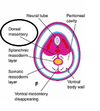Thoracic Cavity Development Flashcards
Pleural Cavities
Space in which lungs develop and persist. Develops from caudal limbs

Pericardial cavity
Space in which heart develops and persists. Develops from the most cranial end of the intraembryonic coelom. Embryo undergoes the head-fold, bringing the pericardium and heart ventrocaudally to bring its position anterior to the foregut.

Peritoneal Cavity
Space in which abdominal viscera develops and persists. Herniation of small intestine and portion of large intestine. Develops from caudal limbs

Septum Transversum
Develops into the center tendon of the thoracic diaphragm
Intraembryonic Coelom
Space in the embryo. Primordium of embryonic body cavities. Develops in 4th week, ends by 8th. During the 4th week, a horseshoe cavity develops in the lateral mesoderm via apoptosis. Most cranial aspect gives rise to pericardial cavity/voelom.

Caudal limbs
Future pleural and peritoneal cavities. Open to the extraembryonic coelom to accommodate the growth and movement of the developing organs. Lose connection with the extraembryonic coelom during 10th week of development as developing intestines return to the body cavity.
Head Fold
Cranial end undergoes head fold. Brings pericardium and heart ventrocaudally. Developing heart now anterior to foregut. Brings pericardial coelom/angioblastic cord (earliest sign of heart) at ~4 weeks. Inflow to heart will come in from inferior aspect, outflow from heart will come out of superior aspect.

Lateral fold
Caudal limbs undergo caudal and lateral (horizontal) folds. Lateral folds bring the caudal limbs together which fuse to form the peritoneal cavity. Results in a gut tube suspended between two layers of membrane (mesentery) suspended from the body wall of the embryo.

Ectopia Cordis
congenital malformation in which the heart is abnormally located either partially or totally outside of the thorax. The ectopic heart can be found along a spectrum of anatomical locations, including the neck, chest, or abdomen. In most cases, the heart protrudes outside the chest through a split sternum.
Mesentery
Double layer of peritoneum extending from the abdominal wall. Conveys blood vessels, nerves, and lymphatics to the organs. Divide the peritoneal cavity into left and right halves. In each half, both parietal and visceral peritoneum found
Dorsal Mesentery
Permanent structure, provides the route for the vasculature, nerves and lymphatics to get to developing organs

Ventral Mesentery
Not permanent. Remains attached to caudal portion of foregut (primordial stomach and proximal aspect of duodenum). Becomes lesser omentum, falciform ligament, and visceral peritoneum surrounding the liver. Any of the mesentaries attached to liver are Ventral mesentary.

Parietal Peritoneum
Serous membrane attached to and covering the abdominal wall
Visceral peritoneum
Serous membrane attached to/associated with internal organs
Pericardioperitoneal Canals
Term used for the intraembryonic coelom after the folding of the embryo. Tubes! Lies lateral to the foregut (future esophagus) and dorsal to the septum transversum (future central tendon of the diaphragm). Partitions form in each canal due to developing bronchial buds which divide developing lungs from pericardial space. The phrenic nerve can get caught up in these folds.








